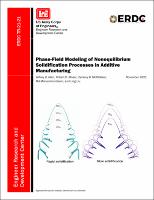Please use this identifier to cite or link to this item:
https://hdl.handle.net/11681/42605Full metadata record
| DC Field | Value | Language |
|---|---|---|
| dc.contributor.author | Allen, Jeffrey B. | - |
| dc.contributor.author | Moser, Robert D. | - |
| dc.contributor.author | McClelland, Zackery B. | - |
| dc.contributor.author | Islam, Md Mohaiminul | - |
| dc.contributor.author | Liu, Ling | - |
| dc.date.accessioned | 2021-12-14T20:17:30Z | - |
| dc.date.available | 2021-12-14T20:17:30Z | - |
| dc.date.issued | 2021-11 | - |
| dc.identifier.govdoc | ERDC TR-21-21 | - |
| dc.identifier.uri | https://hdl.handle.net/11681/42605 | - |
| dc.identifier.uri | http://dx.doi.org/10.21079/11681/42605 | - |
| dc.description | Technical Report | en_US |
| dc.description.abstract | This project models dendrite growth during nonequilibrium solidification of binary alloys using the phase-field method (PFM). Understanding the dendrite formation processes is important because the microstructural features directly influence mechanical properties of the produced parts. An improved understanding of dendrite formation may inform design protocols to achieve optimized process parameters for controlled microstructures and enhanced properties of materials. To this end, this work implements a phase-field model to simulate directional solidification of binary alloys. For applications involving strong nonequilibrium effects, a modified antitrapping current model is incorporated to help eject solute into the liquid phase based on experimentally calibrated, velocity-dependent partitioning coefficient. Investigated allow systems include SCN, Si-As, and Ni-Nb. The SCN alloy is chosen to verify the computational method, and the other two are selected for a parametric study due to their different diffusion properties. The modified antitrapping current model is compared with the classical model in terms of predicted dendrite profiles, tip undercooling, and tip velocity. Solidification parameters—the cooling rate and the strength of anisotropy—are studied to reveal their influences on dendrite growth. Computational results demonstrate effectiveness of the PFM and the modified antitrapping current model in simulating rapid solidification with strong nonequilibrium at the interface. | en_US |
| dc.description.sponsorship | Information Technology Laboratory (U.S.) | en_US |
| dc.description.tableofcontents | Abstract .................................................................................................................................... ii Contents .................................................................................................................................. iii Figures and Table .................................................................................................................... iv Preface ...................................................................................................................................... v 1 Introduction ...................................................................................................................... 1 1.1 Background ........................................................................................................ 1 1.2 Objective ............................................................................................................ 4 1.3 Approach ............................................................................................................ 5 2 Solidification Modeling with the Phase-Field Method ................................................ 6 2.1 Governing equations ......................................................................................... 6 2.1.1 Derivation and mathematical details ......................................................................... 6 2.1.2 Final nondimensional equations and modified antitrapping model ...................... 10 2.2 Numerical solution ..........................................................................................11 3 Material Properties ........................................................................................................ 14 4 Results and Discussion ................................................................................................. 15 4.1 SCN alloy ..........................................................................................................15 4.2 Si-As alloy ......................................................................................................... 17 4.2.1 Effects of solidification rates .................................................................................... 17 4.2.2 Effects of antitrapping models ................................................................................. 18 4.2.3 Dendrite evolution ..................................................................................................... 20 4.2.4 Effects of surface energy anisotropy ....................................................................... 21 4.3 Ni-Nb alloy ....................................................................................................... 22 5 Conclusion ...................................................................................................................... 24 References ............................................................................................................................. 26 Report Documentation Page | - |
| dc.format.extent | 35 pages / 1.15 MB | - |
| dc.format.medium | - | |
| dc.language.iso | en_US | en_US |
| dc.publisher | Information Technology Laboratory (U.S.) | en_US |
| dc.publisher | Geotechnical and Structures Laboratory (U.S.) | - |
| dc.publisher | Engineer Research and Development Center (U.S.) | - |
| dc.relation.ispartofseries | Technical Report (Engineer Research and Development Center (U.S.)) ; no. ERDC TR-21-21 | - |
| dc.rights | Approved for Public Release; Distribution is Unlimited | - |
| dc.source | This Digital Resource was created in Microsoft Word and Adobe Acrobat | - |
| dc.subject | Additive manufacturing | en_US |
| dc.subject | Dendrites--Growth | en_US |
| dc.subject | Binary systems (Metallurgy) | en_US |
| dc.subject | Solidification | en_US |
| dc.subject | Directional solidification | en_US |
| dc.title | Phase-field modeling of nonequilibrium solidification processes in additive manufacturing | en_US |
| dc.type | Report | en_US |
| Appears in Collections: | Technical Report | |
Files in This Item:
| File | Description | Size | Format | |
|---|---|---|---|---|
| ERDC TR-21-21.pdf | 1.15 MB | Adobe PDF |  View/Open |